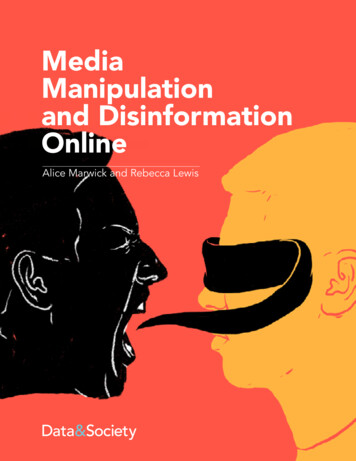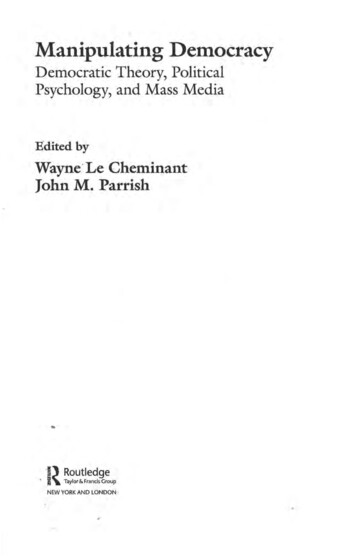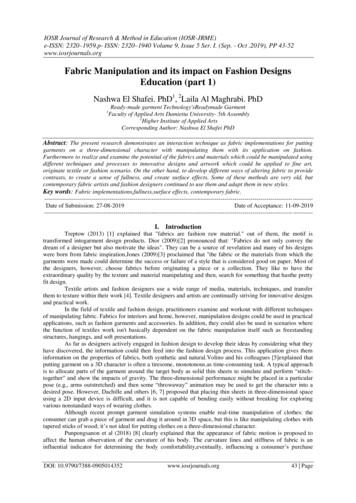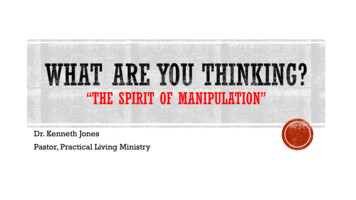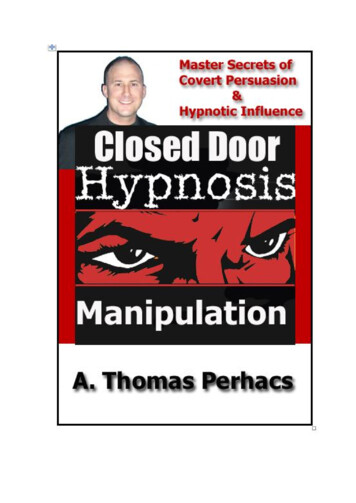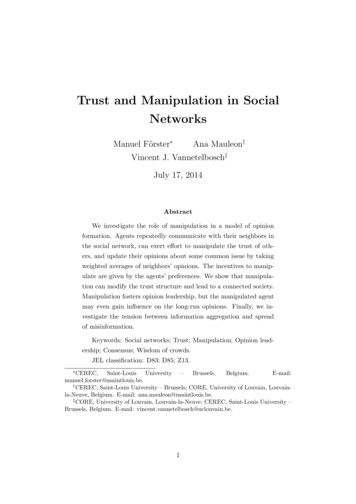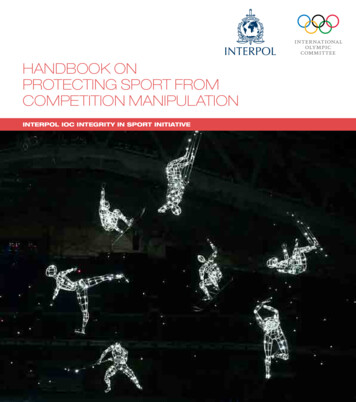
Transcription
International Journal on Studies in English Language and Literature (IJSELL)Volume 3, Issue 7, July 2015, PP 16-26ISSN 2347-3126 (Print) & ISSN 2347-3134 (Online)www.arcjournals.orgLanguage Manipulation in MediaMs. Suzan Ismael WadiDr. AsmaaAwad AhmedEnglish Language CenterUniversity of Sharjah, Sharjah, UAEswadi@sharjah.ac.aeEnglish Language CenterUniversity of Sharjah, Sharjah, UAEaawad@sharjah.ac.aeAbstract: This research paper shall apply critical discourse analysis (CDA) tools to demonstrate how thesame piece of news is reported by two different sources of media in a way that attempts to position the reader ina certain stance. By doing so, it will demonstrate how media texts are not as objective or neutral as they claimto be and do not mirror the world but rather shapes it through the way it reports events. The two pieces of newsselected for the study are: “Israel Raid Kills Palestinian Civilians” reported by Al Jazeera Online (presented inappendix 1) and “Palestinian Woman Dies in Israeli Missile Strike” reported by the International HeraldTribune newspaper (presented in appendix 2).Background theory to critical discourse analysis will be reviewedalong with a discussion of the controversial debate about CDA, followed by an analysis that seeks to comparetwo news articles using CDA tools such as framing, genre, foregrounding and presupposition, topicalization,agency, modality.Keywords: Tools of inquiry, critical discourse analysis (CDA), framing, genre, foregrounding, presupposition,topicalization, agency and modality.1. INTRODUCTIONHow we use language –whether spoken or written- and in which context it reflects who we are, whatwe think value and feel. James Paul Gee (2014) describes a number of “tools of inquiry” andstrategies for applying them. For him, “tools of inquiry” are aimed to explain what an academic takesto be essential in “a domain”. Thus, “when theories about a domain differ, tools of inquiry will differas well”. Discourse analysis is one of these tools of inquiry that as Manning (2008) states“demonstrates the way that the communicative forces of discourse collectively result in meaning” (p.81). It helps us understand particular language choices and what is meant by them in particularcontexts. This research paper will employ critical discourse analysis tools to illustrate how the samepiece of news is conveyed by two different newspapers in a way that tries to side the reader in aspecific position. By applying the CDA tools to the two texts, the researchers shall demonstrate howmedia texts are neither impartial nor impersonal. Background theory to critical discourse analysis willbe reviewed along with a discussion of the controversial debate about CDA, followed by an analysisthat seeks to compare two news articles using CDA tools such as framing, genre, foregrounding,presupposition, topicalization, agency and modality.2. BACKGROUND THEORY ON CRITICAL DISCOURSE ANALYSISPeople wrongly sometimes view language as merely a means of communicating information. Thisthough is an oversimplification of the multiple purposes of a language. As Gee (2014, p.1) states,human language serves many other functions, and the two most closely related functions would be “tosupport the performance of social activities and social identities and to support human affiliationwithin cultures, social groups, and institutions.” This means that language details create social,cultural as well as political activities, values and consequently identities.Gee (2014, p.35) believes that we need to study discourses and go beyond studying language alone inorder to study language in use. He describes discourses as “ways with words, deeds and interactions,thoughts and feelings that allow us to enact and recognize different socially situated identities”.Yule (1996, p.129) defines discourse analysis as “the study of language use with reference to thesocial and psychological factors that influence communication”.Beliefs, values or ethics underlying a text are rarely explicit or directly stated. They usually tend to behidden or implied and this is where critical discourse analysis (CDA) becomes a valuable approach to ARCPage 16
Ms. Suzan Ismael Wadi & Dr. AsmaaAwad Ahmedexplore a text and reveal these „hidden‟ values and ideologies (Paltridge, 2000, 2006). As Thornbury(2005) states, writers use language to create a point of view and to position the reader this point ofview. This language in use or discourse is socially influential and gives rise to important issues ofpower. Discursive practices may help produce unequal power relations between, for example, socialclasses and ethnic majorities and minorities through the ways in which they represent things andposition people (Van, p.258). CDA is considered a form of intervention in social practice and socialrelationships. It examines actual examples of social interaction which take a “linguistic form” anddeals with discourse as a form of social practice which indicates a “dialectical relationship” between acertain “discursive event and the situations, institutions and social structure which frame it”. Thedialectical relationship is two-way: “the discursive event is shaped by situations, institutions andsocial structures, but it also shapes them” (Van, p.258).CDA intervenes on the side of the oppressedagainst the oppressor and openly “declares the emancipatory interests that motivate it” (Fairclough &Wodak, 1997, p. 259).Huckin (1997) points out that CDA is „highly context-sensitive‟ because it explores a text in terms ofthe social context in which the text occurred. CDA takes an ethical standpoint and questions socialand cultural issues like race, gender, identity and ideology and how they are reflected in a particulartext. He believes that we need to go beyond revealing these dogmas and criticize them in order tobring about justice.In another place, Celce-Murcia and Olshtain (2000, p.10) support this view by stating that thesignificance of CDA lies in its interest to “ expose social inequality as expressed, constituted, andlegitimised through language use-notably in the public media ” Critical discourse analysts areconvinced that discourse is never neutral though it may appear so with repeated use. Thereforediscourse must be analysed in terms of the political and social history that it conveys (Celece-Murciaand Olshtain, 2000).According to Huckin (1997), this is one of the main aspects that make CDA different from other typesof textual discourse analysis. He writes that analysts must always take into consideration the largercontext in which the text has occurred rather than look at it in isolation or as words on the page.Fairclough (1992) demonstrates in a diagram this relationship between texts, discursive practices, andsocial practices. Fairclough believes that a text is a product of discursive practices (which includeproduction, distribution and interpretation) that are entrenched in social practices. Thus when morethan one user and social context are involved, a given text will typically have more than one meaning.Paltridge (2006) points out that it is difficult to have a unified view of what CDA is, Fairclough andWadok (1997) nevertheless, give an example of CDA based on eight principles of theory to show howthese affect the practice of CDA. These principles are summarised by Paltridge (2006, p. 284) asfollow: social and political issues are constructed and reflected in discourse Power and relations are negotiated and performed through discourse Discourse both reflects and reproduces social relations Ideologies are produced and reflected in the use of discourseDespite of the apparent just cause of CDA as a tool to analyse written and spoken texts to bring aboutjustice for the oppressed, it has been criticised by some scholars for different reasons. Toolan (1997)argues that CDA needs to be more critical and more demanding of a text linguistics it uses. Hebelieves critical discourse analysts should aim for more thoroughness and strength of evidence in thearguments they make. Van Noppen (2004) points out that CDA is criticised for assuming that thereader of a text is a naïve one who is manipulated, as compared to the insightful academic who canread between the lines and reveal hidden ideology. It is also argued that CDA must not only dependon the analyst‟s view of the text alone but should also include a discussion of the producer of the textas well as the reader or consumers of the texts (Widdowson, 1998, 2004, cited in Paltridge, 2006, p.309).3. CRITICAL ANALYSIS OF MEDIA DISCOURSESIt is important to study media communication in all its form (television, newspapers, and otheravailable communication forms) because of the important role it plays in mediating society to itself.International Journal on Studies in English Language and Literature (IJSELL)Page 17
Language Manipulation in MediaFairclough (2002) points out the influential and formative position of the media in contemporarysocieties which makes the analysis of the construction of relations and identities in media texts asignificant constituent in addressing various important socio cultural questions. CDA has been usedby several scholars to examine the reproduction of power relations in news discourse. Matheson(2005) believes discourse analysis of the media analyses which representations of the social worldpredominate and what kinds of interactions media texts set up between people and the world. Itanalyses how meaning is made differently in different media texts thus showing what different waysof thinking and seeing are found there.This means that news does not simply mirror the world as journalists may claim (Fowler, 1991;Matheson, 2005; Fairclough, 1995). News makes sense within a social context, and as Fowler (1995)argues news is a practice, a product, of the social and political world on which it reports. Thus whennews constructs a picture of the world, that picture is often very close to what members of the societyalready know (Matheson, 20005). This is why Fairclough (2002) stresses the importance of applying acritical perspective in the analysis of texts from different dimensions. O‟Hallorn (2003) states thatCDA highlights manipulative news texts in a way that shows how news texts can „mystify‟ the natureof the event being reported or who was responsible for actions associated with the event.To support the notion that news does not mirror the world but rather shapes it through the way itreports events, two news articles from two different sources reporting the same event are criticallyanalysed in this paper to demonstrate how authors of these two news articles use language and wordsto define the political ideologies they stand for. The first news article is entitled “Israel raid killsPalestinian Civilians” reported by Al Jazeera (presented in appendix 1), an online version of AlJazeera news broadcasting channel that covers world news targeting the Arab world. The second newsarticle covering the same events is entitled “Palestinian woman dies in Israeli missile strike”(presented in appendix 2). It is reported by the International Herald Tribune newspaper which ispublished by different publishers around the world.4. THE ANALYSIS OF THE TEXTS AND DISCUSSIONAlthough Huckin (1997) admits that there is no standard methodology in analysing a text from acritical perspective, nonetheless he highlights the one that he believes proved to be valuable for him inhis work. He recommends in carrying out analysis, to first read a text just like an ordinary readerwho would read the text in an uncritical way, and then revisit the text again critically at differentlevels to explore it as a whole, then at sentence level and then at word and phrase level.4.1. The Text as a Whole4.1.1. GenrePaltridge (2006) explains that critical discourse analysis begins by determining what genre the textstands for, and then it may examine how far beyond the norms of that genre has the writer of the textgone in order to produce a certain effect on the reader. This genre knowledge allows the analysts todetermine and interpret what has been omitted from the text and what was not left out and whatpurpose that omission would serve the producer of the text (Huckin, 1997).A question arises here though is how do we assign a text to a particular genre? Paltridge (2006)discusses various factors that help us decide this. The author of the text and the intended audience aswell as considering the purpose of the text and the situation in which it occurred could influence ourdecision. Also the content of the text and the level of formality of the text and the particular uses oflanguage in the text are other factors that help us decide the genre of a text (Paltridge, 2006).Considering these factors we can assign the two texts chosen here to the genre of „news report‟ textswhere an event that took place in Gaza Strip is covered. “Media claims of their impartiality” and tocover facts and report them objectively without bias in a clear, undistorted language which is designedto be agreeable to the reader (Pekarová, 2011). To the uncritical reader, the two texts may appear toconfirm with these expectations. However, on reading the two texts critically and comparing themtogether, an analyst would notice that the reporters have inserted what Huckin (1997) has described as„loaded words‟ to slant the report. The language used in both reports is not exactly neutral orobjective. This will be further demonstrated in analysing the texts at sentence and word level and byhighlighting what is fore grounded and back grounded in each article.International Journal on Studies in English Language and Literature (IJSELL)Page 18
Ms. Suzan Ismael Wadi & Dr. AsmaaAwad Ahmed4.1.2. FramingHuckin (1997) points out that framing, foregrounding and back grounding are closely related as theyrefer to the perspective from which the writer wants to present content of the text; what viewpoints thewriter aims to „emphasise‟ or „de-emphasise‟. In analysing an extract from radio news, Fairclough(1995) shows how the analysis of „framing‟ draws attention to how features of the report caninfluence the interpretation of the discourse and that is how framing can be deliberately manipulative.In both news reports by Al Jazeera and the International Herald, the contents are presented in a formalfactual language, containing quotes and comments of prominent political figures from both sides ofthe conflict. Quotes by prominent Israeli political figures are reported in the Herald Tribune whileonly one Palestinian voice by the Palestinian president is reported. Similarly, quotes by Palestinianpolitical figures are reported and included in Al Jazeera news report as opposed to only one by Israeliair force commander.In Al Jazeera the news report is framed in a way that foregrounds the suffering and killings of thePalestinian civilians including children as a result of the Israeli occupation and air raids. Images ofinjured children accompany the news report to highlight the injustice Israel is inflicting on thePalestinians. Huckin (1997) suggests that visual aids are a powerful way of framing a text. Thus, thereport frames the shelling and homemade rockets within the context of a violent aggressive Israelioccupation.On the other hand, the news report in the Herald Tribune is framed in a way that attempts to justifythe Israeli air raids on Gaza. It reports the air strikes, but it is framed in a way that foregrounds thecrisis these air raids killing civilians are causing in the Israeli government. The report typically framesIsraeli missiles within the context of Israeli response to the firing of Palestinian homemade firerockets into Israel with Palestinians as the aggressor.The realities of Palestinian life in Gaza are omitted in this news report. Huckin (1997) writes thatomission is a form of back grounding, because when a writer does not mention something it puts it inthe background and the reader may not raise questions about it. The fact that people in Gaza stillexperience their lives as controlled by Israeli military occupation through violence, siege, isolationand displacement is totally ignored or omitted in the Herald Tribune report. Images are also absentfrom this report and one can assume that if images of the civilians killed were present it would notserve the purpose of the writer of this report, that is, to justify Israel‟s strikes and emphasise that theywere not intended to target civilians; they simply „veered off target‟.4.1.3. PresuppositionPresuppositions are often used by writers to influence the readers and manipulate them. Huckin(1997) defines presuppositions as using the language in a way that takes certain ideas for granted, andYule (1996, p 25) defines presupposition as “something the speaker assumes to be the case prior tomaking an utterance”. The two news reports here presuppose the reader to have backgroundknowledge about the history of the Palestinian- Israeli conflict. The way Al Jazeera news report isframed presupposes that what is worth reporting is the devastating effect Israeli air raids are having onthe lives of Palestinian people and how the United Nations condemns Israel‟s attacks, while the waythe report is framed in the Herald Tribune presupposes that what is newsworthy is how Israel justifiesthe air strikes and how the government officials regret that „innocent people paid the price‟.4.2. Analysis by Reading Sentence by Sentence4.2.1. TopicalizationHuckin (1997) states that topicalization is a form of sentence level foregrounding which occurs whencertain pieces of information appear as grammatical subjects of the sentence. What the writer choosesto put in the topic position creates a perspective that influences the readers‟ perceptions. The headlinesin the two news reports are a very good example of this. They clearly describe the same event, theIsraeli missile attack. Al Jazeera‟s headline reads “Israel raid kills Palestinian civilians” which makesIsrael the subject of the sentence who carries out the action of killing Palestinian civilians which arethe object. This makes Israel totally responsible for killing more than one person and connotes a moreviolent description of the event. The Herald Tribune‟s headline is “Palestinian woman dies in Israelimissile attack”. While the Palestinians are still the target of the Israeli attacks, the death of thepalestinian woman appears to happen due to the circumstances and implies that only one person waskilled. This makes the event less dramatic than reporting Israel raid killing many civilians.International Journal on Studies in English Language and Literature (IJSELL)Page 19
Language Manipulation in MediaThe topic of sentences in most of the sentences in Al Jazeera report frames it from a Palestinianperspective making what they say more important than anything else. For example, sentences like thefollowing demonstrate this: A Palestinian woman and one of her relatives have been killed The Palestinian leadership condemned the strike The United Nations urged Israel to stop targeted killings of members of Palestinian To compare it with the Herald Tribune news report, topic sentences are about what the Israelis sayor do: The air strikes have swelled into a crisis for the new Israeli government Peretz faced great criticism in the Knesset Captain Jacob Dallal, a military spokesman, said The Israeli Ynet news service reported 4.2.2. AgencyThe reader needs to pose questions here as to who is the agent. Who is doing what to whom?Language is often used in texts to show certain people as powerful through initiating actions whileothers are portrayed as being the recipients of the actions and therefore passive (Huckin,1997). In alJazeera report Palestinians and United Nations officials are shown as the agents condemning theIsraeli attacks. This is apparent in sentences like “UN disturbed” and “Palestinian leadershipcondemned”. Israel is given the agency when it vows to continue the aggression regardless of the livesof civilians lost. Throughout the report in the Herald Tribune, Israeli officials have the agency throughtheir responses and comments about the air raids. Palestinian militants have agency only when theyare portrayed to initiate the attacks by firing „hundreds of homemade missiles‟ and thus justifyingIsrael‟s air raids.4.3. Analysis at Word and Phrases Level4.3.1. Connotations/ModalityPaltridge (2000) and Huckin (1997) explain that at word and phrase level we need to analyse someconnotations employed by the writer as well as the choice of words that express different degrees ofmodality depending on how a writer/speaker wants to portray his own level of commitment to an ideaor action. According to Fairclough (1992) modality in grammar was associated with the modalauxiliary verbs which are an important means of realizing modality. He reports that Hodge and Kress(1988) draw upon an approach to grammar that considers modal auxiliaries as only one modalityfeature among many. There are tenses, modal adverbs such as „possibly‟, „obviously‟ and theirequivalent modal adjectives.In the Herald Tribune report we can consider the use of the word „contend‟ in this sentence:„Palestinians and human rights contend the Israeli military fired a missile onto the beach‟ whichimplies less certainty to Israel‟s responsibility for the beach massacre. Also the modal auxiliary„could‟ is used in this sentence: „The shrapnel could have been from an Israeli shell or a bomb plantedby Palestinian militants‟. This low modality leaves open the possibility of negotiation. In Al Jazeerareport it is noticed that people with a high degree of authority and status use high modality in order toemphasize an idea. For example the UN secretary general says „Israeli actions should be proportionateand in accordance to humanitarian law.” Israeli air force commander uses high modality „have to‟ toimply that Israel has no other alternative but to fight what they call terrorism and thus continue firingmissiles at Palestinian targets. It is worthy of note here that the use of numerous modal verbs in bothreports indicates that each journalist‟s “subjective assessment” of the newsis intended to involvereaders in the “communicative context”. “The use of modal verbs allows the writers to engage thereaders dialogically in the subjective assessment of any proposition.”(Zarina,P 2013,p.4)5. CONCLUSIONThis analysis of the two news reports has illustrated how the same piece of news from two differentsources can be reported from two different perspectives thereby supporting the argument that newsInternational Journal on Studies in English Language and Literature (IJSELL)Page 20
Ms. Suzan Ismael Wadi & Dr. AsmaaAwad Ahmeddoes not mirror the world but rather shapes it through the way it reports events (Fowler, 1991;Matheson, 2005; Fairclough, 1995). Each author of the above mentioned news articles use languageand words to state the political beliefs they stand for. The critical analysis of the two reports has alsofulfilled the primary purpose of CDA which is to uncover hidden values and ideologies that canpropagate injustice and, as O‟Hallorn (2003) puts it, to draw attention to how manipulative news textscan mystify the nature of the event or who was responsible for the actions in the reported event.How a text may influence readers will vary from one reader to another depending on their beliefs andapproaches towards different issues in life and depending on how each reader may interpret andcomprehend a particular text. As Paltridge (2006) explains, texts cannot be isolated from the socialrealities and processes they contribute to preserve.Language and politics are indeed inseparable from one another. Without understanding language, it isnot possible to understand politics, because politics exist in language. It is the kind of language we usethat defines certain political ideologies we stand for. Language has and still plays a crucial role inframing and shaping the Palestinian-Israeli conflict. Analysing the two media texts criticallyhighlights the role discourse (language in use) plays in creating a point of view and positioning thereader that view. Applying CDA tools to the two pieces of news exemplifies how the same piece ofnews is conveyed by two different newspapers in a way that endeavors to position the reader in acertain position. By doing so, it proves how media messages are not as neutral as they claim to be.REFERENCESAl Jazeera Net, “Israeli Raid kills Palestinian Civilians”. Al Jazeera, from 1A-4642-AE5B-C9460D253A22.htm, (2006, June 21).Brown, K., Developing Critical Literacy. National Centre for English Language Teaching andResearch, Sidney (1999).Celce- Murcia, M. and E. Olshtain, Discourse and Context in Language Teaching: A Guide forLanguage Teachers. Cambridge: Cambridge University Press, (2000).Erlanger, S. and Fisher, I. (2006). Palestinian Woman dies in Israeli missile strike. InternationalHerald Tribune. Retrieved June 22, 2006, from http://www.iht.com/bin/print ipub.php?file /articles/2006/06/21/news/mideast.phpFairclough, N. Discourse and Social Change. Cambridge: Polity Press (1992).Fairclough, N. Media Discourse. London; New York: E. Arnold (1995).Fairclough, N. and R. Wodak. “Critical discourse analysis”. In T. A. Van Dijk (ed), Discourse associal interaction. London: Sage. (1997).Fairclough, N. “Identity and social relations in media texts”. In M. Toolan (ed.), Critical discourseanalysis: Critical concepts in linguistics. New York: Routledge. (2002).Fowler, R. Language in the news: Discourse and ideology in the press. London; New York:Routledge. (1991).Gee, J. An Introduction to Discourse Analysis: Theory and Method. Fourth edition. London:Routledge. (2014).Huckin, T.N. “Critical Discourse Analysis”. In T. Miller (ed.), Functional Approaches to WrittenText: Classroom Applications. Washington, DC: United States Information Agency. (1997).“Language and Literacy in a Changing World”, Open Education, (22th June 2015), nt/view.php?id 15196&printable 1Manning, A Language and Linguistics. Garnet LTD, UK, (2008).Matheson, D. Media discourses: Analysing media texts. Maidenhead, England; New York: OpenUniversity Press. (2005).O‟Halloran, K. Critical discourse analysis and Language Cognition. Edinburgh: EdinburghUniversity Press. (2003).Paltridge, B. Making Sense of Discourse Analysis. Gold Coast, Queensland: Antipodean EducationalEnterprises. (2000).Paltridge, B. Discourse Analysis. University publishing services: The University of Sydney. (2006).Pekarová, Radoslava, Evaluative Language in Journalistic Discourse, Masaryk University, CzechRepublic. (2011).International Journal on Studies in English Language and Literature (IJSELL)Page 21
Language Manipulation in Mediahttp://is.muni.cz/th/217152/ff m/Evaluative language in journalistic discourse.docxx (1-June-2015)Trimarco, P Digital Texuality, CPI Group, UK, 2015.http://tinyurl.com/puchzox (20-May-2015).Thornbury, S. Beyond the Sentence: Introducing Discourse Analysis. London: Macmillan. (2005).Toolan, M. „What is critical discourse analysis and why are people saying such terrible things aboutit?‟Language and literature, 6, 2.83-103. (1997).Van Dijk, A. Discourse as a Social Interaction. 11 June 2015.http://tinyurl.com/o6977nzzVan Noppen, J-P, “CDA: A discipline come of age?”Journal of Sociolinguistics, 8, 107-126. (2004).Wennerstrom, A. Discourse Analysis in the Language Classroom. Volume 2. Genres of Writing. AnnArbor: University of Michigan Press. (2003).Yule, G. Pragmatics. Oxford: Oxford University Press. (1996).Zarina, P. Modality Analysis of the Newspaper Articles about the, Academic Journal ofInterdisciplinary Studies, Vol. 2, No. 9, MCSER Publishing-Rome, Italy (2013).AUTHORS’ BIOGRAPHYDr. AsmaaAwad Ahmed is an ESL Instructor in the ELc, University of Sharjah.She has PhD in Comparative Literature, MA in English Language and Literature andCELTA. She has been teaching English for 20 years in different parts of the world.Her area of interest is Comparative Literature and Education Technology.Suzan Ismael Wadi is an ESL instructor and assistant director in the ELC,University of Sharjah. She has a Master‟s degree in TESOL from The University ofSydney- Australia, and has been teaching English for 20 years in different parts ofthe world. Her area of research interest is socio linguistics.International Journal on Studies in English Language and Literature (IJSELL)Page 22
Ms. Suzan Ismael Wadi & Dr. AsmaaAwad AhmedAppendix 1International Journal on Studies in English Language and Literature (IJSELL)Page 23
Language Manipulation in MediaInternational Journal on Studies in English Language and Literature (IJSELL)Page 24
Ms. Suzan Ismael Wadi & Dr. AsmaaAwad AhmedAppendix 2International Journal on Studies in English Language and Literature (IJSELL)Page 25
Language Manipulation in MediaInternational Journal on Studies in English Language and Literature (IJSELL)Page 26
Language Manipulation in Media Ms. Suzan Ismael Wadi English Language Center University of Sharjah, Sharjah, UAE swadi@sharjah.ac.ae Dr. AsmaaAwad Ahmed English Language Center University of Sharjah, Sharjah, UAE aawad@sharjah.ac.ae Abstract: This research paper shall apply criti
